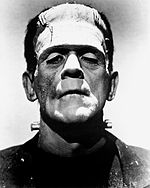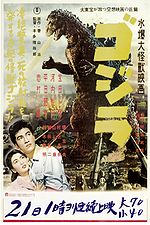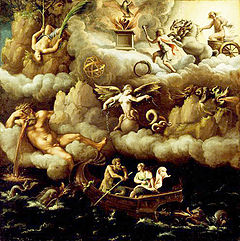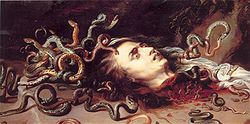- Monster
-
This article is about the legendary creature of monsters. For other uses, see Monster (disambiguation).
A monster is any fictional creature, usually found in legends or horror fiction, that is somewhat hideous and may produce physical harm or mental fear by either its appearance or its actions. The word "monster" derives from Latin monstrum, an aberrant occurrence, usually biological, that was taken as a sign that something was wrong within the natural order.[1]
The word connotes something wrong or evil; a monster is generally morally objectionable, physically or psychologically hideous, and/or a freak of nature. It can also be applied figuratively to a person with similar characteristics like a greedy person or a person who does horrible things.
Contents
Monsters in legend
Ancient Greco-Roman, Celtic, Semitic, Norse, Chinese and Sumerian folklore all had a wealth of legendary beasts. Some of the most famous include:
- Cerberus
- Charybdis
- Chimera
- Cyclops
- Dragon
- Hydra
- Kelpie
- Medusa the Gorgon
- Midgard Serpent
- Minotaur
- Scylla
Monsters in film
Pre–World War II
 Hollywood's interpretation of Frankenstein's monster, played by Boris Karloff.
Hollywood's interpretation of Frankenstein's monster, played by Boris Karloff.
During the age of silent movies, monsters tended to be human-sized, e.g., Frankenstein's monster, the Golem, werewolves and vampires. The film Siegfried featured a dragon that was actually a giant puppet on tracks. A few movie dinosaurs were created with the use of stop-motion animated models, as in RKO's King Kong, the first giant monster film of the sound era.
Universal Studios specialized in monsters, with Bela Lugosi's reprisal of his stage role, Dracula, and Boris Karloff playing Frankenstein's monster. The studio also made several lesser films, such as Man-Made Monster, starring Lon Chaney, Jr. as an electrically reanimated zombie.
There was also a variant of Dr. Frankenstein, the mad surgeon Dr. Gogol (played by Peter Lorre), who transplanted hands that were reanimated with malevolent temperaments, in the film Mad Love.
Werewolves were introduced in films during this period, and similar creatures were presented in Cat People. Mummies were cinematically depicted as fearsome monsters as well. As for giant creatures, the Flash Gordon serial did not use a costumed actor, instead used real-life lizards to depict a large dragon via use of camera perspective. The cinematic monster cycle eventually wore thin, having a comedic turn in Abbott and Costello Meet Frankenstein (1948).
Post World War II
 Original Godzilla movie poster.
Original Godzilla movie poster.
In the post World War II era, however, giant monsters returned to the screen with a vigor that has been causally linked to the development of nuclear weapons, often pitting the monstrous against the scientific elite.[2] One early example occurred in the American film The Beast from 20,000 Fathoms, which was about a dinosaur that attacked a lighthouse. Subsequently, there were Japanese film depictions, (Godzilla, Gamera), British depictions (Gorgo), and even Scandinavian depictions (Reptilicus), of giant monsters attacking cities. The most recent depiction of a giant monster is the monster in J. J. Abrams's Cloverfield, which was released in theaters January 18, 2008. The intriguing proximity of other planets brought the notion of extraterrestrial monsters to the big screen, some of which were huge in size, (such as King Ghidorah and Gigan), while others were of a more human scale. During this period, the fish-man monster Gill-man was developed in the film series Creature from the Black Lagoon.
Britain's Hammer Film Productions brought colour to the monster movies in the late 1950s. Around this time, the earlier Universal films were usually shown on American television by independent stations (rather than network stations) by using announcers with strange persona3, who gained legions of young fans. Although they have since changed considerably, movie monsters did not entirely disappear from the big screen as they did in the late 1940s.
Occasionally, monsters are depicted as friendly or misunderstood creatures. King Kong & Frankenstein's monster are two examples of misunderstood creatures. Frankenstein's monster is frequently depicted in this manner, in films such as Monster Squad and Van Helsing. The Hulk is an example of the "Monster as Hero" archetype. The theme of the "Friendly Monster" is pervasive in pop-culture. Chewbacca, Elmo, and Shrek are notable examples of friendly "monsters". The creatures of Monsters Inc. scare children in order to create energy for running machinery, while the furry monsters of The Muppets and Sesame Street live in harmony with animals and humans alike. Japanese culture also commonly features monsters which are benevolent and/or likeable, with the most famous examples being the Pokémon franchise and the pioneering anime My Neighbor Totoro.
Monsters in gaming
 Card from the Japanese game obake karuta, c. early 19th century. Each card features a monster from Japanese mythology and a character from the hiragana syllabary.
Card from the Japanese game obake karuta, c. early 19th century. Each card features a monster from Japanese mythology and a character from the hiragana syllabary.
Monsters are commonly used in fantasy or role-playing games, especially role-playing video games, when a large number of enemies to fight against are needed. However, the idea has been used across every genre to varying degrees. These can include aliens, all types of legendary creatures, or mutated versions of regular animals. However, sentient fictional races are usually not referred to as monsters. Other times, the term can carry a neutral connotation, such as in the Pokémon franchise, where it is used to refer to fictional creatures that may resemble, but are not, real world animals. Characters in games may refer to all animals as "monsters".
See also
- Cookie Monster
- Cryptozoology
- Demon
- Fouke Monster
- Freak
- Kaiju
- Lake monster
- Legendary creature
- List of monster movies
- List of species in fantasy fiction
- Monster movie
- Mutant
- Mythological hybrid
- Ogre
- Orc
- Sea monster
- Yōkai
References
- ^ David Wardle, Cicero on Divination, Book 1 (Oxford University Press, 2006), p. 102; Mary Beagon, "Beyond Comparison: M. Sergius, Fortunae victor," in Philosophy and Power in the Graeco-Roman World: Essays in Honour of Miriam Griffin (Oxford University Press, 2002), p. 127; Gregory A. Staley, Seneca and the Idea of Tragedy (Oxford University Press, 2010), pp. 109, 113 et passim.
- ^ W. Scott Poole, Monsters in America: Our Historical Obsession with the Hideous and the Haunting (Waco, Texas: Baylor, 2011), p. 122, ISBN 978-1-60258-314-6 .
Categories:- Legendary creatures
- Mythemes
- Horror fiction
- Folklore
- Extraterrestrial life in popular culture
Wikimedia Foundation. 2010.


